Abstract
OBJECTIVES. This study examined the effect of cumulative exposure to work organization--psychological demands, work control, and social support on prospectively measured cardiovascular disease mortality risk. METHODS. The source population was a national sample of 12517 subjects selected from the Swedish male population by Statistics Sweden in annual surveys between 1977 and 1981. Over a 14-year follow-up period, 521 deaths from cardiovascular disease were identified. A nested case-control design was used. Work environment exposure scores were assigned to cases and controls by linking lifetime job histories with a job exposure matrix. RESULTS. Conditional logistic regression analysis was used in examining cardiovascular mortality risk in relation to work exposure after adjustment for age, year last employed, smoking, exercise, education, social class, nationality, and physical job demands. In the final multi-variable analysis, workers with low work control had a relative risk of 1.83 (95% confidence interval [CI] = 1.19, 2.82) for cardiovascular mortality. Workers with combined exposure to low control and low support had a relative risk of 2.62 (95% CI=1.22, 5.61). CONCLUSIONS. These results indicate that long-term exposure to low work control is a risk factor for cardiovascular disease mortality.
Full text
PDF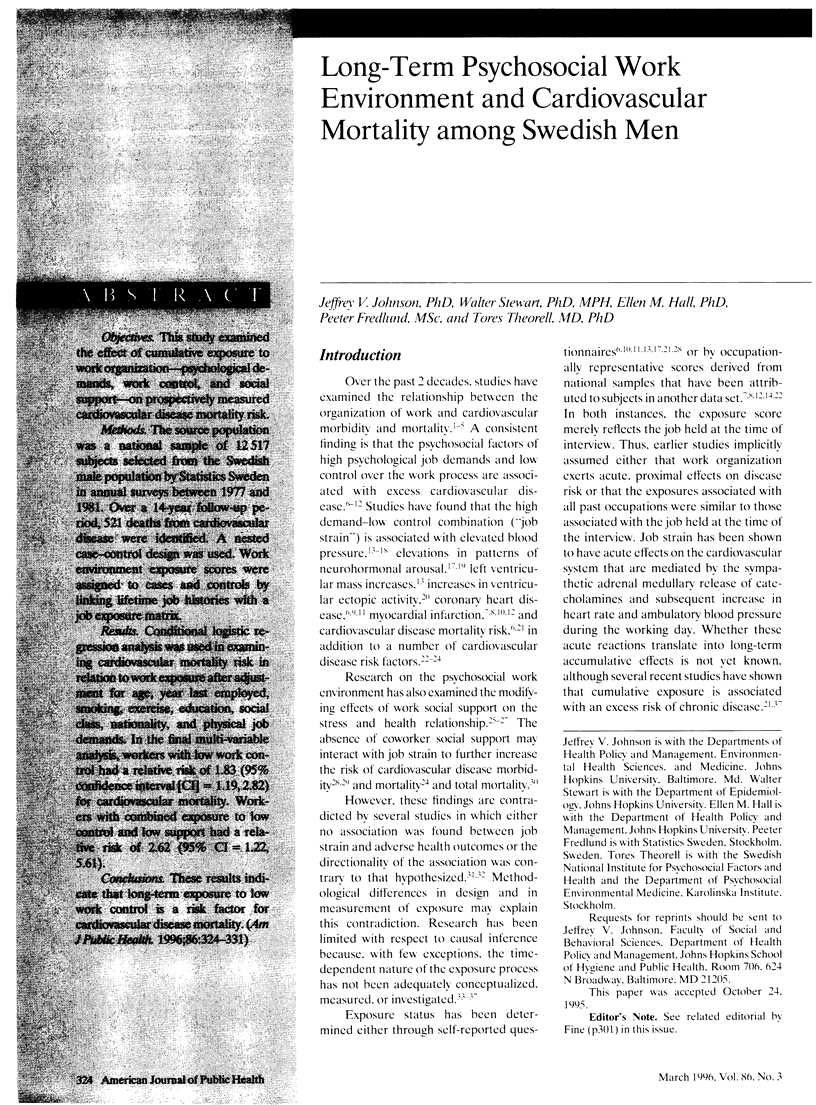

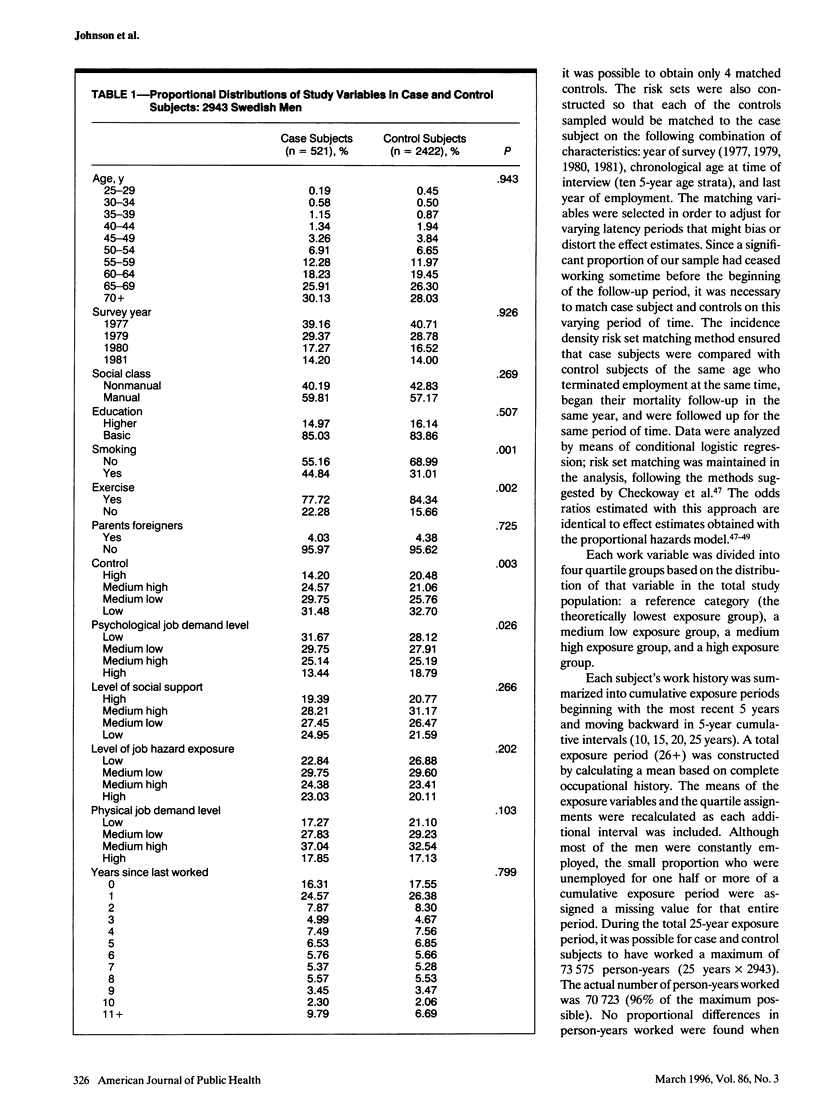
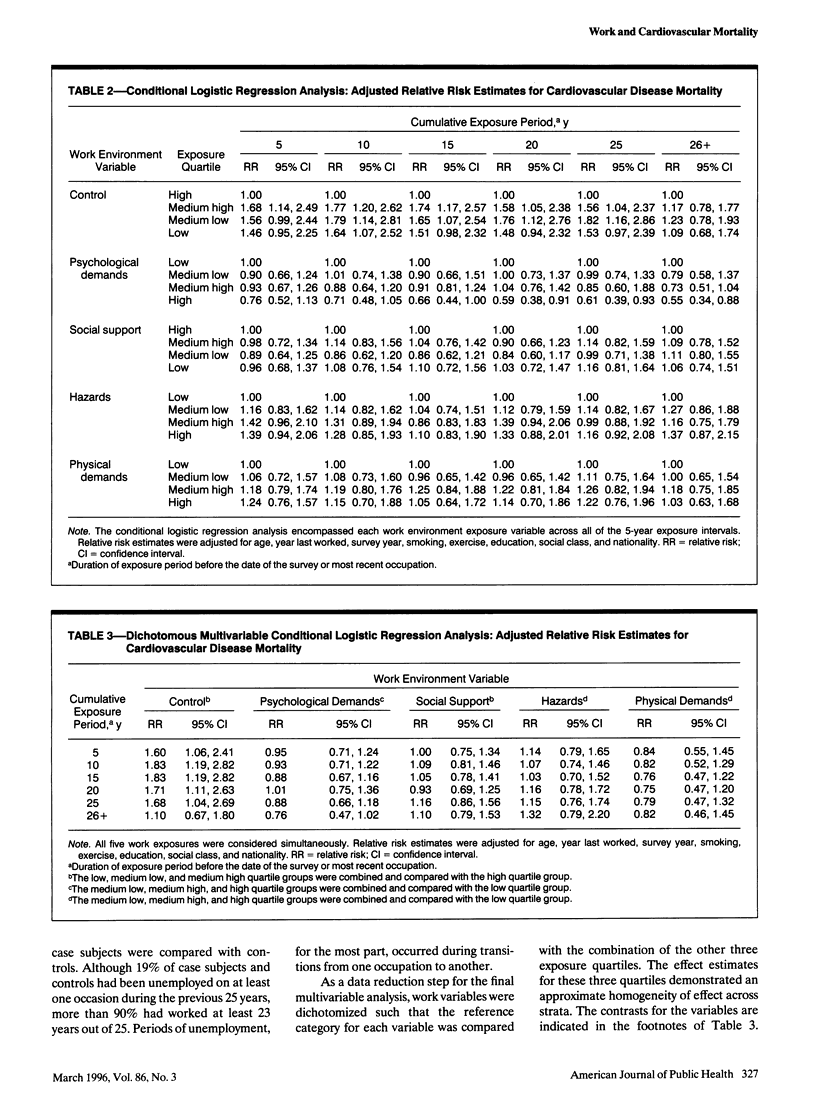

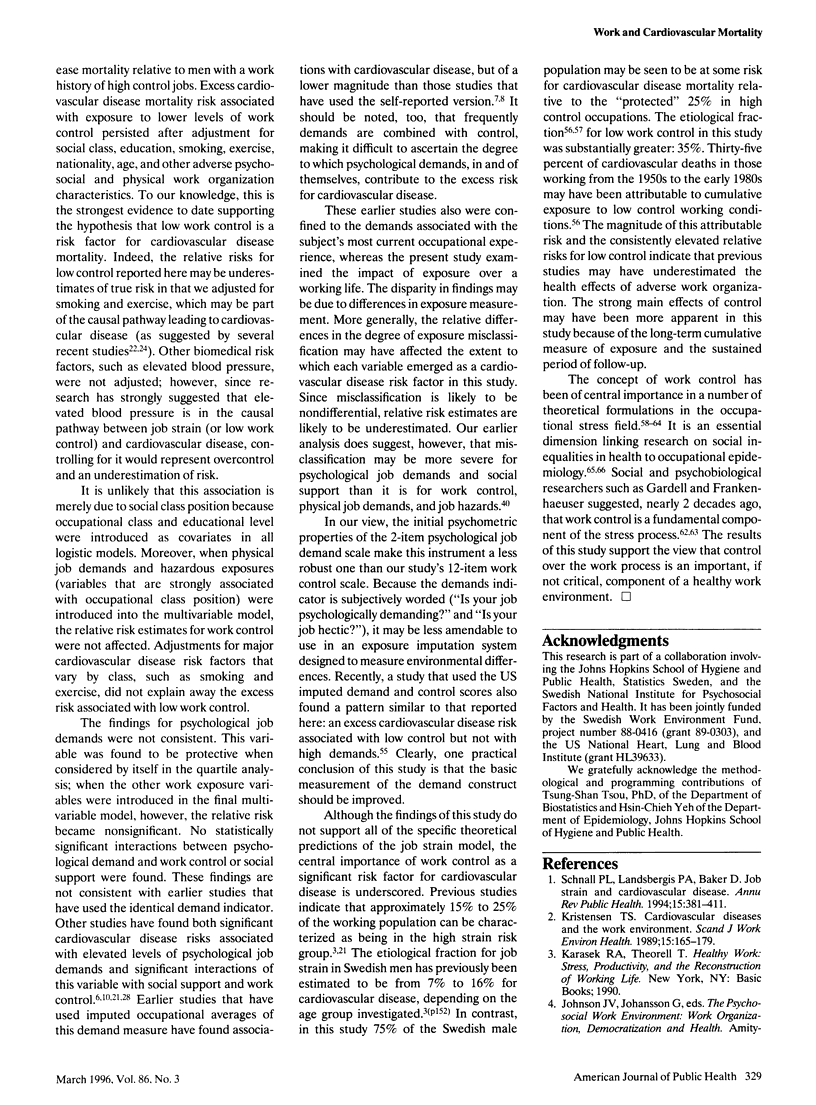
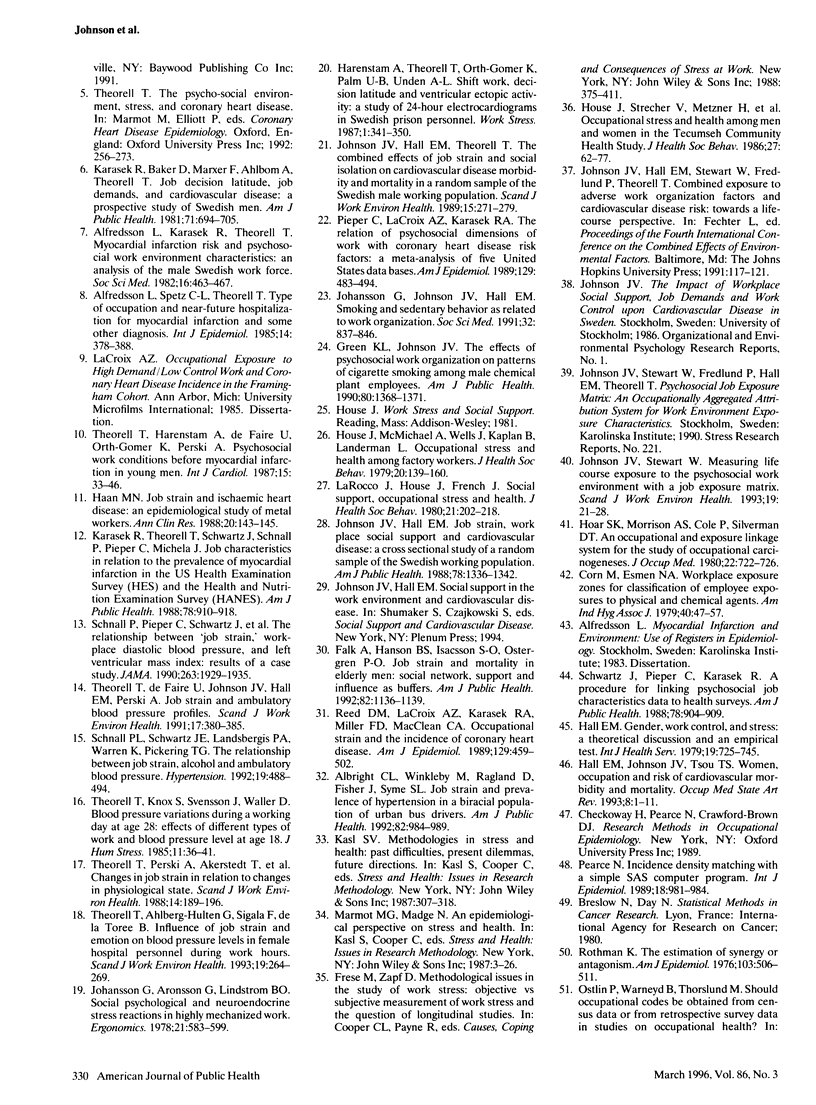
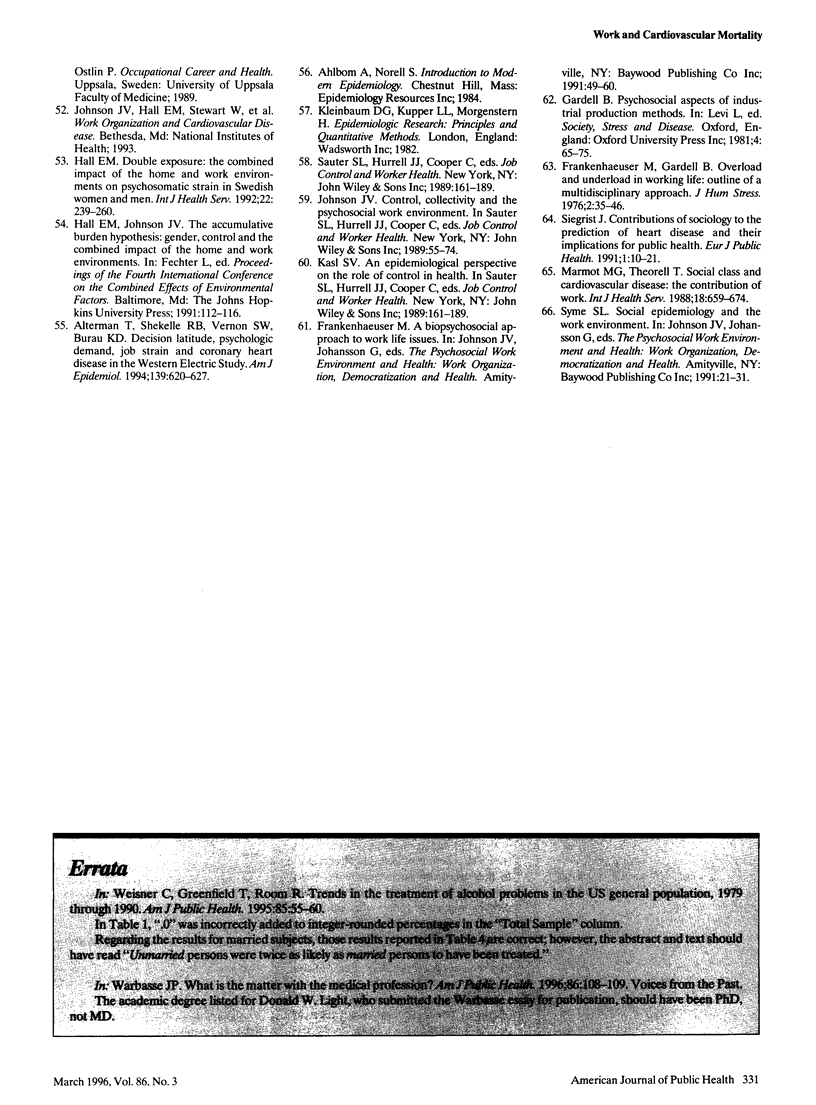
Selected References
These references are in PubMed. This may not be the complete list of references from this article.
- Albright C. L., Winkleby M. A., Ragland D. R., Fisher J., Syme S. L. Job strain and prevalence of hypertension in a biracial population of urban bus drivers. Am J Public Health. 1992 Jul;82(7):984–989. doi: 10.2105/ajph.82.7.984. [DOI] [PMC free article] [PubMed] [Google Scholar]
- Alfredsson L., Karasek R., Theorell T. Myocardial infarction risk and psychosocial work environment: an analysis of the male Swedish working force. Soc Sci Med. 1982;16(4):463–467. doi: 10.1016/0277-9536(82)90054-5. [DOI] [PubMed] [Google Scholar]
- Alfredsson L., Spetz C. L., Theorell T. Type of occupation and near-future hospitalization for myocardial infarction and some other diagnoses. Int J Epidemiol. 1985 Sep;14(3):378–388. doi: 10.1093/ije/14.3.378. [DOI] [PubMed] [Google Scholar]
- Alterman T., Shekelle R. B., Vernon S. W., Burau K. D. Decision latitude, psychologic demand, job strain, and coronary heart disease in the Western Electric Study. Am J Epidemiol. 1994 Mar 15;139(6):620–627. doi: 10.1093/oxfordjournals.aje.a117051. [DOI] [PubMed] [Google Scholar]
- Chia S. E., Foo S. C., Gan S. L., Jeyaratnam J., Tian C. S. Neurobehavioral functions among workers exposed to manganese ore. Scand J Work Environ Health. 1993 Aug;19(4):264–270. doi: 10.5271/sjweh.1475. [DOI] [PubMed] [Google Scholar]
- Corn M., Esmen N. A. Workplace exposure zones for classification of employee exposures to physical and chemical agents. Am Ind Hyg Assoc J. 1979 Jan;40(1):47–57. doi: 10.1080/15298667991429318. [DOI] [PubMed] [Google Scholar]
- Falk A., Hanson B. S., Isacsson S. O., Ostergren P. O. Job strain and mortality in elderly men: social network, support, and influence as buffers. Am J Public Health. 1992 Aug;82(8):1136–1139. doi: 10.2105/ajph.82.8.1136. [DOI] [PMC free article] [PubMed] [Google Scholar]
- Frankenhaeuser M., Gardell B. Underload and overload in working life: outline of a multidisciplinary approach. J Human Stress. 1976 Sep;2(3):35–46. doi: 10.1080/0097840X.1976.9936068. [DOI] [PubMed] [Google Scholar]
- Green K. L., Johnson J. V. The effects of psychosocial work organization on patterns of cigarette smoking among male chemical plant employees. Am J Public Health. 1990 Nov;80(11):1368–1371. doi: 10.2105/ajph.80.11.1368. [DOI] [PMC free article] [PubMed] [Google Scholar]
- Haan M. N. Job strain and ischaemic heart disease: an epidemiologic study of metal workers. Ann Clin Res. 1988;20(1-2):143–145. [PubMed] [Google Scholar]
- Hall E. M. Double exposure: the combined impact of the home and work environments on psychosomatic strain in Swedish women and men. Int J Health Serv. 1992;22(2):239–260. doi: 10.2190/7VW4-GE0D-WRKU-Q62V. [DOI] [PubMed] [Google Scholar]
- Hall E. M. Gender, work control, and stress: a theoretical discussion and an empirical test. Int J Health Serv. 1989;19(4):725–745. doi: 10.2190/5MYW-PGP9-4M72-TPXF. [DOI] [PubMed] [Google Scholar]
- Hoar S. K., Morrison A. S., Cole P., Silverman D. T. An occupation and exposure linkage system for the study of occupational carcinogenesis. J Occup Med. 1980 Nov;22(11):722–726. [PubMed] [Google Scholar]
- House J. S., McMichael A. J., Wells J. A., Kaplan B. H., Landerman L. R. Occupational stress and health among factory workers. J Health Soc Behav. 1979 Jun;20(2):139–160. [PubMed] [Google Scholar]
- House J. S., Strecher V., Metzner H. L., Robbins C. A. Occupational stress and health among men and women in the Tecumseh Community Health Study. J Health Soc Behav. 1986 Mar;27(1):62–77. [PubMed] [Google Scholar]
- Johansson G., Aronsson G., Lindström B. O. Social psychological and neuroendocrine stress reactions in highly mechanised work. Ergonomics. 1978 Aug;21(8):583–599. doi: 10.1080/00140137808931761. [DOI] [PubMed] [Google Scholar]
- Johansson G., Johnson J. V., Hall E. M. Smoking and sedentary behavior as related to work organization. Soc Sci Med. 1991;32(7):837–846. doi: 10.1016/0277-9536(91)90310-9. [DOI] [PubMed] [Google Scholar]
- Johnson J. V., Hall E. M. Job strain, work place social support, and cardiovascular disease: a cross-sectional study of a random sample of the Swedish working population. Am J Public Health. 1988 Oct;78(10):1336–1342. doi: 10.2105/ajph.78.10.1336. [DOI] [PMC free article] [PubMed] [Google Scholar]
- Johnson J. V., Hall E. M., Theorell T. Combined effects of job strain and social isolation on cardiovascular disease morbidity and mortality in a random sample of the Swedish male working population. Scand J Work Environ Health. 1989 Aug;15(4):271–279. doi: 10.5271/sjweh.1852. [DOI] [PubMed] [Google Scholar]
- Johnson J. V., Stewart W. F. Measuring work organization exposure over the life course with a job-exposure matrix. Scand J Work Environ Health. 1993 Feb;19(1):21–28. doi: 10.5271/sjweh.1508. [DOI] [PubMed] [Google Scholar]
- Karasek R. A., Theorell T., Schwartz J. E., Schnall P. L., Pieper C. F., Michela J. L. Job characteristics in relation to the prevalence of myocardial infarction in the US Health Examination Survey (HES) and the Health and Nutrition Examination Survey (HANES). Am J Public Health. 1988 Aug;78(8):910–918. doi: 10.2105/ajph.78.8.910. [DOI] [PMC free article] [PubMed] [Google Scholar]
- Kristensen T. S. Cardiovascular diseases and the work environment. A critical review of the epidemiologic literature on nonchemical factors. Scand J Work Environ Health. 1989 Jun;15(3):165–179. doi: 10.5271/sjweh.1864. [DOI] [PubMed] [Google Scholar]
- LaRocco J. M., House J. S., French J. R., Jr Social support, occupational stress, and health. J Health Soc Behav. 1980 Sep;21(3):202–218. [PubMed] [Google Scholar]
- Marmot M., Theorell T. Social class and cardiovascular disease: the contribution of work. Int J Health Serv. 1988;18(4):659–674. doi: 10.2190/KTC1-N5LK-J1PM-9GRQ. [DOI] [PubMed] [Google Scholar]
- Pearce N. Incidence density matching with a simple SAS computer program. Int J Epidemiol. 1989 Dec;18(4):981–984. doi: 10.1093/ije/18.4.981. [DOI] [PubMed] [Google Scholar]
- Pieper C., LaCroix A. Z., Karasek R. A. The relation of psychosocial dimensions of work with coronary heart disease risk factors: a meta-analysis of five United States data bases. Am J Epidemiol. 1989 Mar;129(3):483–494. doi: 10.1093/oxfordjournals.aje.a115159. [DOI] [PubMed] [Google Scholar]
- Reed D. M., LaCroix A. Z., Karasek R. A., Miller D., MacLean C. A. Occupational strain and the incidence of coronary heart disease. Am J Epidemiol. 1989 Mar;129(3):495–502. doi: 10.1093/oxfordjournals.aje.a115160. [DOI] [PubMed] [Google Scholar]
- Rothman K. J. The estimation of synergy or antagonism. Am J Epidemiol. 1976 May;103(5):506–511. doi: 10.1093/oxfordjournals.aje.a112252. [DOI] [PubMed] [Google Scholar]
- Schnall P. L., Landsbergis P. A., Baker D. Job strain and cardiovascular disease. Annu Rev Public Health. 1994;15:381–411. doi: 10.1146/annurev.pu.15.050194.002121. [DOI] [PubMed] [Google Scholar]
- Schnall P. L., Pieper C., Schwartz J. E., Karasek R. A., Schlussel Y., Devereux R. B., Ganau A., Alderman M., Warren K., Pickering T. G. The relationship between 'job strain,' workplace diastolic blood pressure, and left ventricular mass index. Results of a case-control study. JAMA. 1990 Apr 11;263(14):1929–1935. [PubMed] [Google Scholar]
- Schnall P. L., Schwartz J. E., Landsbergis P. A., Warren K., Pickering T. G. Relation between job strain, alcohol, and ambulatory blood pressure. Hypertension. 1992 May;19(5):488–494. doi: 10.1161/01.hyp.19.5.488. [DOI] [PubMed] [Google Scholar]
- Schwartz J. E., Pieper C. F., Karasek R. A. A procedure for linking psychosocial job characteristics data to health surveys. Am J Public Health. 1988 Aug;78(8):904–909. doi: 10.2105/ajph.78.8.904. [DOI] [PMC free article] [PubMed] [Google Scholar]
- Theorell T., Hamsten A., de Faire U., Orth-Gomér K., Perski A. Psychosocial work conditions before myocardial infarction in young men. Int J Cardiol. 1987 Apr;15(1):33–46. doi: 10.1016/0167-5273(87)90290-7. [DOI] [PubMed] [Google Scholar]
- Theorell T., Knox S., Svensson J., Waller D. Blood pressure variations during a working day at age 28: effects of different types of work and blood pressure level at age 18. J Human Stress. 1985 Spring;11(1):36–41. doi: 10.1080/0097840X.1985.9936736. [DOI] [PubMed] [Google Scholar]
- Theorell T., Perski A., Akerstedt T., Sigala F., Ahlberg-Hultén G., Svensson J., Eneroth P. Changes in job strain in relation to changes in physiological state. A longitudinal study. Scand J Work Environ Health. 1988 Jun;14(3):189–196. doi: 10.5271/sjweh.1932. [DOI] [PubMed] [Google Scholar]
- Theorell T., de Faire U., Johnson J., Hall E., Perski A., Stewart W. Job strain and ambulatory blood pressure profiles. Scand J Work Environ Health. 1991 Dec;17(6):380–385. doi: 10.5271/sjweh.1690. [DOI] [PubMed] [Google Scholar]


